
Indicator scoreboard
Germany - November real seasonally adjusted retail sales - excluding sales of autos- rose 1.6 percent and 1.1 percent when compared with last year. Including sales of autos and at petrol stations, total retail sales were up 1.1 percent on the month and 0.6 percent on the year.

Gross domestic product for the year 2001 is estimated to have grown by 0.6 percent when compared to last year. This was the weakest performance since the recession of 1993, when GDP fell 1.1 percent. On a workday adjusted basis, real GDP rose by 0.8 percent. GDP rose 3.0 percent in 2000. Construction investment contracted 5.7 percent last year, worse than the decline of 2.5 percent in 2000. Equipment investment shrank 3.4 percent in 2001, after surging by 8.7 percent the year before. All other GDP components registered growth in 2001.
November manufacturing orders were up a revised 0.7 percent but down from the originally reported increase of 0.9 percent. Foreign orders were revised down to an increase of 2.0 percent from an original 2.2 percent increase, while domestic orders were revised down to a decline of 0.5 percent from the originally reported 0.4 percent drop. West German orders were revised down to an increase of 1.0 percent from 1.1 percent while in the east, orders were revised up to a drop of 4.5 percent from the originally reported decline of 5.8 percent.
December wholesale prices rose 0.1 percent but were down 1.5 percent when compared with last year. A sharp jump in seasonal food prices was offset by lower oil prices. Excluding seasonal food prices, wholesale prices fell 1.6 percent and 0.3 percent on the year. Excluding oil products, wholesale prices rose 0.5 percent on the month but were down 0.2 percent on the year.
France - November manufacturing output fell 0.2 percent and 1.9 percent when compared with last year. Industrial output excluding construction was unchanged on the month and down 0.9 percent on the year. Autos were down 1.5 percent after a 2.6 percent drop in October, and semi-finished goods were down 0.5 percent after a 0.4 percent decline in October.
November seasonally adjusted merchandise trade surplus widened to E2.135 billion. Exports fell 3.1 percent and were down 7.3 percent when compared with last year. Imports dropped 5.2 percent and were 13.8 percent lower on the year.
Italy - November seasonally and workday adjusted industrial production dropped 2.6 percent and 5.7 percent when compared with last year. The 2.6 percent drop is the largest since December 1992. The index has now posted five consecutive year-on-year declines. November consumer goods' output fell 3.0 percent, investment goods dropped 3.7 percent while intermediate goods shed 1.9 percent.
Britain - November manufacturing output fell 0.7 percent and was down by 5.4 percent from levels a year earlier. This was the largest annual decline in the series since September 1991. The decline was led by significant drops in electrical and optical equipment, basic metals and metal products and machinery and equipment industries output. The wider measure of industrial production fell 0.3 percent and 4.8 percent on the year.

December seasonally adjusted producer input prices fell 0.7 percent and 6.6 percent on the year. They were dragged lower by a continued decline in the cost of crude oil. Crude oil prices fell by 4.7 percent on the month and 28.4 percent on the year. The impact of this drop was partly offset by a rise in gas, electricity and home-produced food materials prices. Excluding food, beverages, tobacco and petroleum, seasonally adjusted output prices were also unchanged on the month and were up 0.1 percent on the year.

December retail price index (RPI) slipped 0.1 percent but was up 0.7 percent when compared with last year. This is the lowest annual rate since March 1960 when it declined 0.5 percent. The retail price index excluding mortgage interest payments (RPIX) was up 0.2 percent and 1.9 percent when compared with last year. The RPIX remains well below the Bank of England's 2.5 percent inflation target.

November average earnings growth eased to 4.2 percent from a downwardly revised October figure of 4.3 percent. Manufacturing earnings growth slowed to 3.6 percent from 4.3 percent in the previous month. Service sector earnings remained steady at 4.2 percent in November and private-sector services earnings rose to 3.9 percent from 3.7 percent in October. Average earnings growth is under the Bank of England's target growth rate of 4.5 percent.
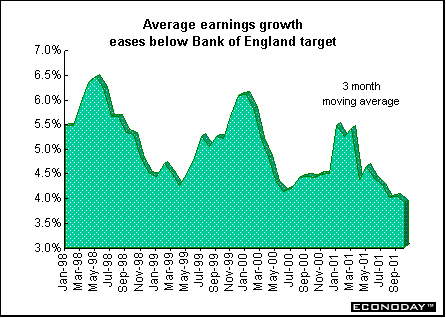
December claimant count unemployment rose by 3,200, following an upwardly revised 6,000 increase in the previous month. The International Labour Organization measure of unemployment also rose by 15,000 in the three months, September to November, compared with the previous three months. Despite the rise in unemployment, employment increased in the latest three month period. The number of people in employment rose 65,000 in the latest 3-month period according to the latest Labor Force Survey figures. Manufacturing jobs continued to be lost, with the workforce survey showing manufacturing employment down by 17,000 in the latest month and by 45,000 in the latest 3-month period (to September 2001).
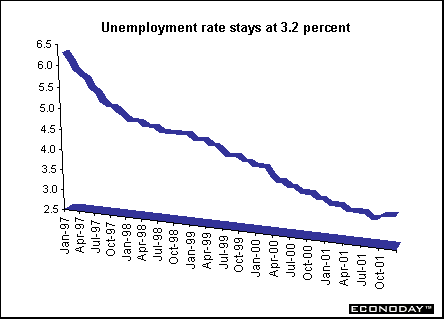
December retail sales fell 0.3 percent but rose 5.7 percent when compared with last year. This was the first monthly decline in sales since April 2000. The December drop in sales volumes was led by a decline in clothing and footwear sales, which were down 1.9 percent on the month but still up 8.7 percent on levels a year earlier.
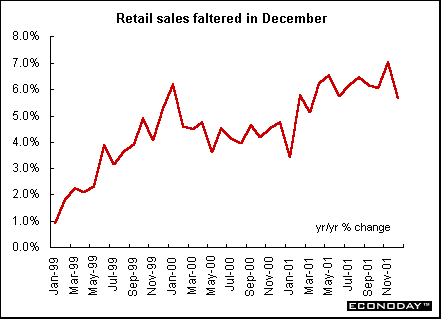
Asia
Australia - December seasonally adjusted unemployment rate remained at 6.7 percent. The economy lost 8,500 jobs as tourism-related companies fired staff because of a slump in international visitors. The economy lost 16,500 full-time jobs in December. That was balanced by 8,100 extra part-time positions. The unemployment rate was unchanged as fewer people looked for work. The participation rate, which measures the number of people in work or looking for jobs as a percentage of the population, fell to 63.4 percent from 63.5 percent.
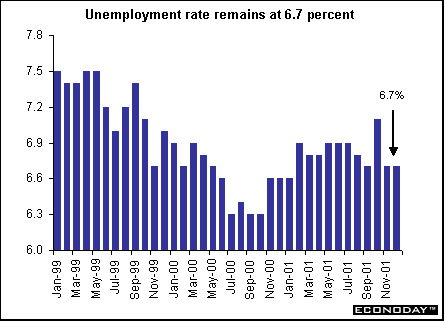
Japan - November seasonally adjusted current account surplus widened to 1.36 trillion yen ($10.2 billion), from 1.19 trillion yen in October. The trade surplus, which accounts for about two-thirds of the current account, rose as imports dropped. Export earnings rose 1.4 percent, buoyed by the weaker yen. Imports fell 4.2 percent. The merchandise trade surplus widened to 899.5 billion yen in November from 719.7 billion yen in October. Cheaper oil also helped Japan, which imports most of its oil. The income account surplus, which tracks dividends and interest payments, fell to 889.2 billion yen in November from 919.6 billion yen in October. The services deficit, which includes overseas travel, narrowed to 347.5 billion yen in November from October's 357.6 billion yen, as vacationers shunned international travel after the terror attacks on the U.S.
November factory use fell 1.5 percent to the lowest since the Ministry of Economy, Trade and Industry started keeping records in 1978. On the year it plummeted 10.4 percent. Capacity, which measures the overall size of the manufacturing industry, fell 3 percent. Production fell 1.7 percent. Shipments fell 1.4 percent. Inventories fell 1.4 percent.
Americas
Canada - November merchandise trade surplus was C$4.56 billion, up from C$4.06 billion in October. Exports were up 1.3 percent while imports declined 0.3 percent. Canadian trade surplus with the United States declined to C$6.77 billion. Merchandise exports to the United States declined 0.4 percent while imports rose 0.7 percent. Merchandise trade deficit with all other countries improved by nearly three-quarters of a billion dollars to just over C$2.2 billion because of substantially higher exports. Exports rose for machinery and equipment, automotive products and industrial goods and materials. Imports of machinery and equipment and aircraft and other transportation equipment were down while imports of motor vehicle parts rose.
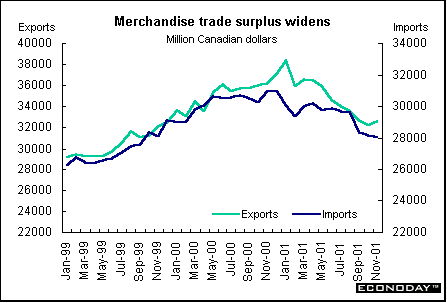


Introduction • Global
Stock Market Indexes • Recap of Global Markets
• Currencies • Indicator
Scoreboard

The Bottom Line •
Looking Ahead
|